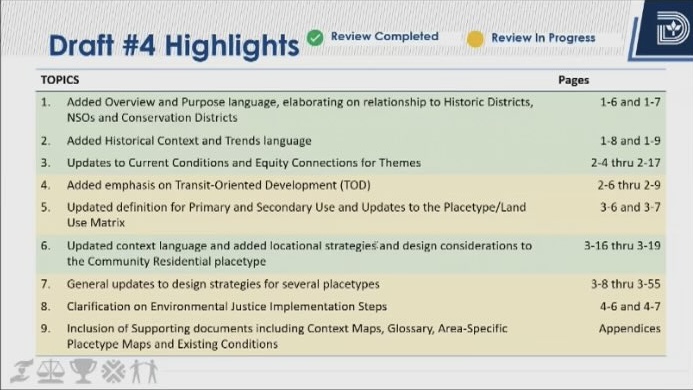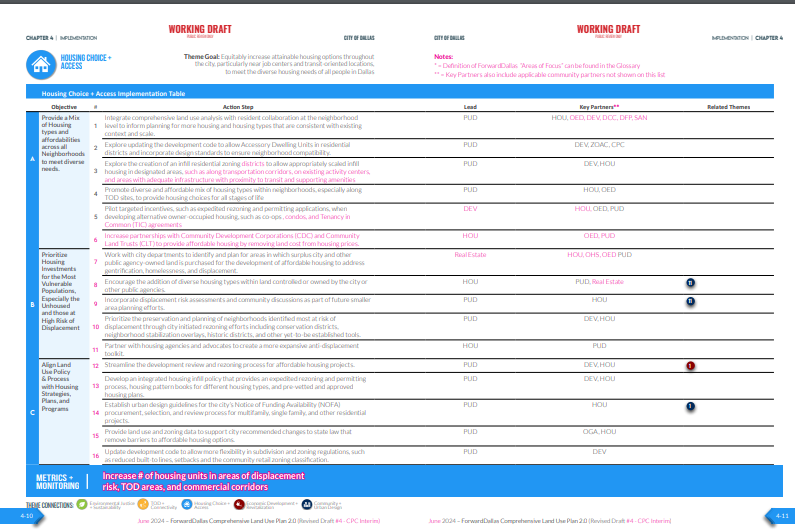(Candy’s Dirt) – It’s become challenging to offer a fresh perspective on the myriad public hearings, town halls, and detailed discussions on Dallas’ comprehensive land use plan update.
The arguments have been the same for months. Housing advocates want more housing. Some longtime residents are concerned that greater density will change the character of their single-family neighborhoods. Arguments have been made that the plan won’t address affordability and will create a burden on infrastructure.
Those against the plan, deemed ForwardDallas 2.0, and those who support it have shown up repeatedly at City Hall to voice their concerns. Hundreds of others have emailed comments and shared their thoughts on social media.
But the 45 people who spoke at a City Plan Commission hearing on Thursday represent just a fraction of Dallas’ 1.3 million residents.
On Thursday night, it appeared some members of the City Plan Commission had enough with what they referred to as “blatant inaccuracies” propagated by those who oppose the plan.
Watch the July 11 City Plan Commission meeting.
The matter will be taken up again on July 25 with a public hearing beginning at 12:30 p.m. Once the CPC agrees on a document to recommend, it will go before the Dallas City Council for adoption.
What Does ForwardDallas Do?
Originally developed by the Comprehensive Land Use Plan Committee of volunteer residents, ForwardDallas is one of several factors taken into account when reviewing development proposals, according to public documents.

“ForwardDallas also identifies areas where there are inconsistencies between the current use on the ground today, the desired future vision for the area, and the existing zoning needed to implement the vision,” the ForwardDallas website states. “Specifically, ForwardDallas has identified environmental justice areas where incompatible uses and zoning exist (commonly residential next to industrial) and recommends an updated future land use vision for those areas to guide future zoning efforts.”
The plan is currently under review by the City Plan Commission, a 15-member panel appointed by the City Council and chaired by District 11 resident Tony Shidid.
Compromises have been offered, such as removing multiplexes as a primary use in the Community Residential and Small Town Residential “placetypes” and changing the definition of multiplex to eight or fewer units. Additionally, historic districts, conservation districts, neighborhood stabilization overlays, and other neighborhood-led efforts including planned development districts are protected from land use guidelines outlined in the plan.
What Changed on Thursday
A couple of key amendments were introduced late Thursday evening and supported by a majority of CPC members. Lest we be accused of plan-splaining, here they are as read into the record:
Commissioner Lorie Blair proposed to “remove cottage courts and tiny homes as an example of single-family detached land uses and cottage courts as an example of single-family attached land uses and to amend Objective 2 of the Housing Choice + Access Implementation Table on page 4-10 to add cottage courts and tiny homes to that objective, which would explore updating the development code in residential districts to allow cottage courts and tiny homes and incorporate design standards to ensure neighborhood compatibility.”

This moves cottage courts and tiny homes to the same place as accessory dwelling units within the implementation table, Blair explained. Another plan commissioner explained that the action takes cottage courts and tiny homes out of the matrix, signifying there’s no intent to place such development in single-family neighborhoods.
CPC Vice Chair Brent Rubin proposed considering “the development of a displacement-mitigation overlay for use in areas facing significant risk of residential displacement, as identified through appropriate metrics. In contrast to the Neighborhood Stabilization Overlay, which often takes significant time to implement because it is highly customizable, the potential displacement-mitigation overlay should be ‘turnkey’ and may have design standards applicable to new construction that draw from existing residential development in the area. (E.g., square footage of new development in overlay limited to 150% of average square footage of existing residences on block).”
“It’s not going to be easy,” Rubin said. “It will be a challenging experience at [Zoning Ordinance Advisory Committee] and at Council, but as Commissioner Blair said, we don’t run from big, bold challenges here at the horseshoe.”
Plan Commissioners Seek Clarity During Public Hearing
Former City Councilwoman Diane Ragsdale, who also previously served on the CPC, reminded neighbors that ForwardDallas does not change the zoning application process.
“Although the Community Residential placetype is largely single-family, we don’t want that to exclude the possibility that in some places in the future, other types of housing may make sense in order to provide more housing options for more people,” Ragsdale said. “We don’t want a plan that is exclusionary. We don’t want a plan that is classist or racist, nor do we want a plan that allows the construction of grossly incompatible housing … which has led to displacement.”
At the end of the public hearing, commissioners called Ragsdale back to the podium to clarify the roles of the CPC and City Council when it comes to zoning decisions.
“It is a guide; it is not a mandate,” Ragsdale said. “I do believe that the CPC and the council will never be robbed of their zoning authority. The desire of the community in many ways is what tends to drive the decision-making related to zoning … It would be absolutely irresponsible for you to ignore the community in spite of the plan.”
District 14 resident Melanie Vanlandingham asked for more specificity in the plan.
“ForwardDallas is filled with contradictory, vague language and few specifics, leading to misuse, teardowns, incompatible infill, displacement, and higher taxes,” she said. “It offers zero strategies for affordability. It sacrifices all single-family neighborhoods in Dallas. If you claim otherwise, then explicitly say that and show that multifamily isn’t intended within single-family neighborhoods.”
CPC Commissioner Tom Forsyth has often been the lone voice in supporting the wishes of single-family neighborhoods in opposition to the plan. He commended Vanlandingham for her comments.
“I think it’s fair to say that you’re not opposed to density, but you believe that if city planners state that they are not targeting single-family neighborhoods with missing middle housing, then they should be willing to state that in the plan,” Forsyth told the speaker.
Commissioners Push Back
CPC Vice Chair Rubin pointed out that ForwardDallas says that planned development districts are protected. Vanlandingham reiterated that the language should be more specific, which led to a debate over the development code. Commissioners Christian Chernock, Tabitha Wheeler-Reagan, and Lorie Blair also tried to find common ground with the speaker, who has attended numerous meetings and appears to be familiar with the plan’s contents.
Vanlandingham said state law dictates that zoning follows the land use plan. Developers will point to the intent of the plan and the CPC is obligated to approve their projects on that basis, she said.
That didn’t sit well with Chair Shidid. At this point in the meeting, commissioners spent several hours on the zoning docket prior to the ForwardDallas public hearing.
“Are you stating that on every case today at this hearing, our hands were tied to follow the recommendation that’s in ForwardDallas?” Shidid said. “That’s your position. That’s not what happened here at the horseshoe today. You implied that our hands were tied by the information in the plan, and I can tell you after voting on thousands of cases, that’s absolutely, categorically incorrect.”
Wheeler-Reagan pointed out that several cases are held under advisement in each CPC meeting so the district commissioner can meet with residents and gather input before making a recommendation. The CPC routinely votes against the guidelines of the land use plan or works with the developer to come up with a solution that is more agreeable to neighbors. On Thursday the panel tabled a request for multifamily development in an area where multifamily already exists because they weren’t sure it would work.
“The majority of the people that are coming down and speaking against this are not the people who are going to be here in the next 10 to 20 years,” Wheeler-Reagan said. “In the next 10 to 20 years, if we do not open the door to density, our children, grandchildren, and great-grandchildren will be living outside of the city of Dallas.”


